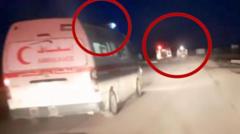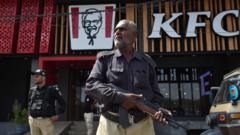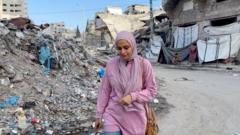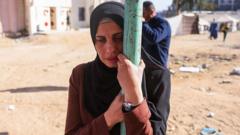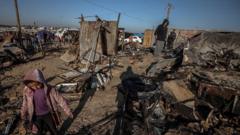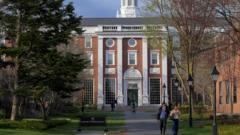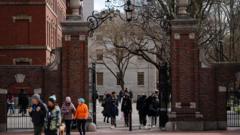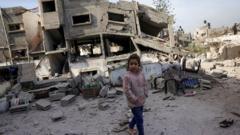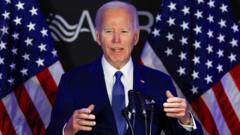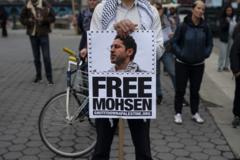As Amsterdam grapples with the aftermath of violent clashes involving Israeli football fans, the city's complex social fabric is tested, revealing tensions between Jewish and Muslim communities. Political repercussions are felt nationwide, raising questions about identity and integration in contemporary Dutch society.
Tensions Erupt in Amsterdam Amid Violence and Political Fallout
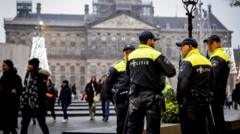
Tensions Erupt in Amsterdam Amid Violence and Political Fallout
Unrest stemming from recent violence between football fans highlights deep-seated issues within Dutch society, prompting urgent calls for community healing.
It’s been a week since Amsterdam's streets were marked by violence that erupted when Israeli football fans were attacked, leaving the city to confront the unease beneath its surface. The local government has attributed the clashes to a “toxic combination of antisemitism, hooliganism, and anger” stemming from ongoing conflicts in Gaza and the broader Middle East.
The situation intensified when Maccabi Tel Aviv supporters arrived for a Europa League match against Ajax, and events quickly spiraled out of control, culminating in violent outbursts against attendees and widespread vandalism. Amidst the chaos, the fragility of relations between Amsterdam’s Jewish and Muslim communities has been starkly illuminated. Local Rabbi Lody van de Kamp poignantly described the buildup to the incidents as a potential “tinderbox,” precipitated by discontent surrounding the ongoing conflict.
In the aftermath of the violence, political ramifications have emerged. The Dutch coalition government is under strain, with tensions heightened following the resignation of a junior minister from Moroccan descent, who cited alarming racist language used by colleagues during a cabinet meeting. Critics argue that this rhetoric unfairly scapegoats the Moroccan community, complicating integration discussions for longstanding residents.
Local observers highlight that these incidents have a historic echo, as violence coincided with the anniversary of Kristallnacht, a night of horror for Jewish communities in Germany in 1938, making the recent violence particularly impactful. Despite attempts by both communities to come together during this time of crisis, fears of rising antisemitism and Islamophobia are evident.
As citizens process the aftermath, some Jewish residents have taken precautions, such as removing mezuzahs from their homes out of fear of retaliation, illustrating the deep emotional toll on this community. Meanwhile, Muslims in the city express concern over being unfairly blamed for actions taken by a minority, as societal polarization deepens.
Amid calls for de-escalation and open dialogue from community leaders and academics, Amsterdam’s Mayor Femke Halsema emphasizes the importance of understanding the intersectionality of these challenges, insisting that ant-Semitism must not lead to further racial divides.
As Amsterdam attempts to confront its complex identity as a multicultural city, residents must navigate these difficult conversations. Rabbi van de Kamp’s reflection resonates: “We are allowed to be very angry, but we must never hate,” urging a collective path forward amidst discord.
The situation intensified when Maccabi Tel Aviv supporters arrived for a Europa League match against Ajax, and events quickly spiraled out of control, culminating in violent outbursts against attendees and widespread vandalism. Amidst the chaos, the fragility of relations between Amsterdam’s Jewish and Muslim communities has been starkly illuminated. Local Rabbi Lody van de Kamp poignantly described the buildup to the incidents as a potential “tinderbox,” precipitated by discontent surrounding the ongoing conflict.
In the aftermath of the violence, political ramifications have emerged. The Dutch coalition government is under strain, with tensions heightened following the resignation of a junior minister from Moroccan descent, who cited alarming racist language used by colleagues during a cabinet meeting. Critics argue that this rhetoric unfairly scapegoats the Moroccan community, complicating integration discussions for longstanding residents.
Local observers highlight that these incidents have a historic echo, as violence coincided with the anniversary of Kristallnacht, a night of horror for Jewish communities in Germany in 1938, making the recent violence particularly impactful. Despite attempts by both communities to come together during this time of crisis, fears of rising antisemitism and Islamophobia are evident.
As citizens process the aftermath, some Jewish residents have taken precautions, such as removing mezuzahs from their homes out of fear of retaliation, illustrating the deep emotional toll on this community. Meanwhile, Muslims in the city express concern over being unfairly blamed for actions taken by a minority, as societal polarization deepens.
Amid calls for de-escalation and open dialogue from community leaders and academics, Amsterdam’s Mayor Femke Halsema emphasizes the importance of understanding the intersectionality of these challenges, insisting that ant-Semitism must not lead to further racial divides.
As Amsterdam attempts to confront its complex identity as a multicultural city, residents must navigate these difficult conversations. Rabbi van de Kamp’s reflection resonates: “We are allowed to be very angry, but we must never hate,” urging a collective path forward amidst discord.

